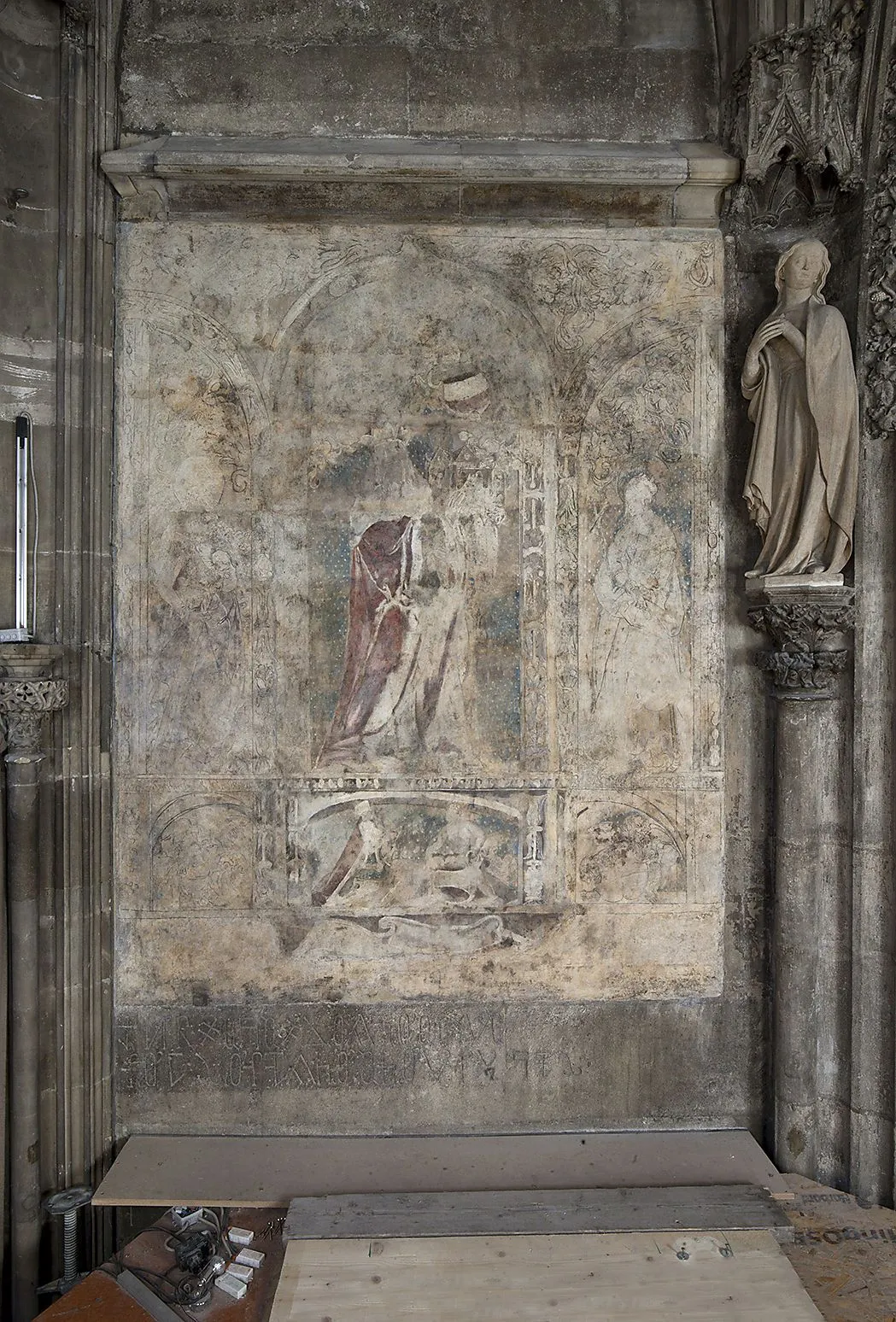Artwork Discovered in Vienna Cathedral’s Gift Shop May Be the Work of German Renaissance Master Albrecht Dürer
The find is particularly intriguing because it represents the first evidence that Dürer visited the Austrian city
:focal(403x217:404x218)/https://tf-cmsv2-smithsonianmag-media.s3.amazonaws.com/filer/26/85/2685603d-8679-4762-89a4-f4e0dc56a3a5/durer.jpg)
During recent restoration work at St. Stephen’s Cathedral, a historic Vienna landmark with roots stretching back to the 12th century, experts made a remarkable discovery in a section of the church that now functions as a gift shop. Per a statement from Austria’s Federal Monuments Office, a previously unknown artwork that scholars think was rendered by the studio of German Renaissance master Albrecht Dürer—and perhaps even by the artist himself—has emerged from beneath layers of dirt.
The wall painting takes the form of a two-dimensional triptych with Saint Leopold, patron of Austria, in the center, flanked by Saint Catherine and Saint Margaret. Below them, reports Martin Bailey of the Art Newspaper, is “a predella-type image” resembling the base of an altarpiece.
Experts are particularly interested in the underdrawings of Saint Catherine and Saint Margaret, which were etched onto fresh plaster in approximately 1505. These drawings are “undoubtedly by an artist from the circle of Dürer,” according to a cathedral statement quoted by Bailey. But Dürer specialist Erwin Pokorny goes one step further, telling Bailey he is “certain” the drawings were done by the master himself because “none of Dürer’s assistants or followers were able to reach the quality of the underdrawing’s virtuoso brushstrokes.”
The St. Stephen’s work may have been commissioned by Holy Roman Emperor Maximilian I, who was born in Austria and added to its territory during his rule. As art historian Michael Rainer tells Viennese daily Die Presse, a 17th-century biography of Dürer details a wall painting ordered by the emperor, but no other records of the commission survive. Until now, says Rainer, the work has been viewed as a lost legend.
Just a few years after the underdrawings were made, Maximilian enlisted Dürer as an official court artist. But if Dürer started the artwork, he failed to finish it for reasons that now remain unclear. Saint Leopold and the predella appear to have been executed by another artist in the 1510s. The colored paint, writes Bailey, was applied “slightly later.”

Born in Nuremberg in 1471, Dürer rose to prominence as a painter, draftsman and printmaker. Today, Encyclopedia Britannica notes, he is “generally regarded as the greatest German Renaissance artist.”
Two known trips to Italy had a seminal influence on Dürer’s body of work. Antonio Pollaiuolo’s studies of the body in motion, for instance, sharpened Dürer’s interest in the human form. His Feast of the Rose Garlands, an energetic panel commissioned by German merchants in Venice, shows clear influences of Venetian color and design, according to the Metropolitan Museum of Art.
Dürer also made well-documented journeys to the Netherlands, and is known to have maintained ties with Dutch painters. But until the underdrawings surfaced at St. Stephen’s Cathedral, there had been no indication that Dürer ever visited Vienna. The discovery thus raises interesting questions about how Dürer may have been influenced by the art of the Austrian city—and how he may have influenced the artists who lived there.
Why Dürer went to Vienna represents another interesting line of inquiry. He could have stopped there on his way from Nuremberg to Venice; according to Bailey, the British Museum owns an inscribed Dürer drawing of a woman from Windisch, an area in southern Austria along this route. Or Dürer may have traveled to Vienna to visit his friend Conrad Celtis, a German humanist scholar who lived in the city between 1497 and 1508.
The discovery is exciting because Dürer was previously known to have created just one other set of wall paintings. Adorning the Nuremberg town hall, the murals were designed by Dürer but executed by other artists. All traces of these works were lost when the town hall was destroyed during World War II.
St. Stephen’s has launched a major conservation project for the triptych, and research on the painting is due to be published in an Austrian art and preservation magazine later this year.
Pokorny, for one, needs no further convincing that the underdrawings were rendered by Dürer’s own hand.
As he says in the statement, “It is not a question of whether, but when Dürer was in Vienna.”